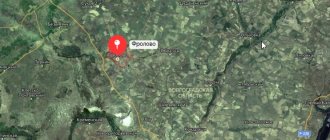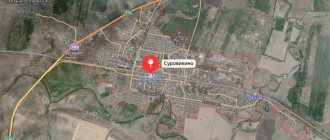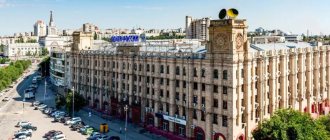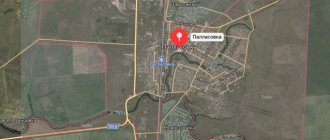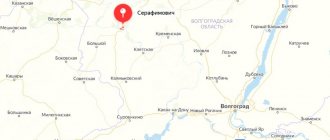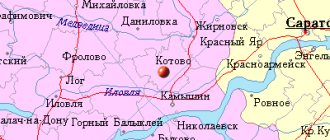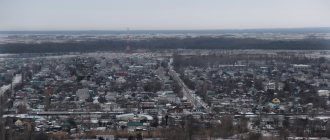Volgograd is a large city with a population of over a million, located on the right bank of the Volga, its length is more than 8 km. Today, in 2022, the current population of Volgograd is 1,008,998 people. It received its first name from the Tsar, based on the names of the two rivers Itil and Tsarina. The object was named Tsaritsyn. The second name of Volgograd from 1925 to 1961 was Stalingrad. It is located on the western side of the Volga River. Volgograd is also located together with such cities as Volzhsky, as well as Krasnoslobodsk.
They are located on the eastern side of the river and together form part of the Volgograd agglomeration. Trade crews passed through the reservoirs, conducting trade relations and developing logistics. Intellectual power and commercial activity are well developed here. The disadvantages of Volgograd include: the lack of jobs and the closure of all production enterprises and organizations.
Current statistics
More than 1 million residents live on the territory of Volgograd. The average age is 41 years, the environmental situation is in a deplorable state. There are 10% more women than men. Women - 54%, men - 46%. The number of people of disabled age is 22%. If we count by the number of residents, then per 1000 Volgograd residents there are only 10% of births and 13% of deaths.
Population density is unevenly distributed in the city. Fewer citizens live in older areas than in new buildings. Based on statistical data, the number of residents occupying the area of the new Dzerzhinsky district is 190,000 people, Krasnoarmeysky 168,000.
Volgograd is divided into 8 parts, between which stretch deserted, lingering hills. These areas are not residential, since the administrative staff considers organizing the construction of apartment complexes to be labor-intensive and costly from an economic point of view.
Main settlements of Volgograd:
- Traktorozavodskaya.
- Krasnooktyabrsky
- Dzerzhinsky.
- Central.
- Voroshilovsky.
- Soviet.
- Kirovsky.
- Krasnoarmeysky.
Population in municipal, urban areas
It arose around 1555 on an island near the left bank of the Volga, but was soon moved to the cape of the right bank at the confluence of the Tsaritsa River into the Volga, from which it received the name Tsaritsyn.
On the site of modern Volgograd, between the Sukhaya and Mokraya Mechetka rivers, there was a Horde settlement with an unknown name. Russian settlers called its ruins the Mechetny settlement; coins of the Jochi ulus from 1274 to 1377 were found there.
The climate is moderate continental. Winters are mild, with frequent thaws, summers are hot and long.
Now we will tell those interested in the climate in the city of Volgograd, what the average temperature was according to research over the past few years, the maximum and minimum values, as well as the average and norms of precipitation:
Climate of Volgograd (weather, precipitation)
| Index | Jan. | Feb. | March | Apr. | May | June | July | Aug. | Sep. | Oct. | Nov. | Dec. | Year |
| Abs. Max. | 12,3 | 15,8 | 20,5 | 29,2 | 37,7 | 40,1 | 41,8 | 42,6 | 38,8 | 31,5 | 21,0 | 12,3 | 42,6 |
| Avg. Max. | −3,3 | −3,1 | 3,6 | 14,9 | 21,9 | 27,0 | 29,6 | 28,6 | 21,6 | 13,0 | 3,6 | −1,9 | 13,0 |
| Avg. pace. | −5,7 | −5,9 | 0,1 | 9,9 | 16,7 | 21,6 | 24,2 | 23,0 | 16,4 | 8,8 | 0,8 | −4,2 | 8,8 |
| Avg. min. | −9 | −9,7 | −3,9 | 4,2 | 10,1 | 15,1 | 17,5 | 16,2 | 10,4 | 4,1 | −2,4 | −7,3 | 3,8 |
| Abs. min. | −33 | −32,5 | −25,8 | −12,8 | −1,1 | 1,1 | 7,2 | 4,5 | −1,5 | −12,2 | −25,8 | −27,8 | −33 |
| Norm of siege. | 25 | 17 | 19 | 18 | 35 | 22 | 26 | 21 | 18 | 21 | 20 | 24 | 267 |
| Avg. humid | 88 | 86 | 81 | 64 | 57 | 56 | 53 | 51 | 61 | 73 | 86 | 89 | 70 |
Whether the population of the city of Volgograd is decreasing or increasing, what is its official number according to the census as of January 1, 2022, in its municipalities, urban areas, we will learn about this later, when accurate information appears, but for now we will present the currently available figures.
Founding date of Volgograd: 1579
Time zone: MSK, UTS +3
Data by year
The city became a millionaire in 2010. In 2009, the population increased to 981,909 people, 2010 - 1021,215, 2011 - 1021,200, 2012 - 1018,789, 2013 - 1,018,790, 2014 - 1,187,985. The growth line increased unevenly.
A big jump was noticed from 2011 to 2012. It was associated with population migration to Volgograd and an increase in the birth rate. Young people and the working-age population are leaving the locality, the reason is the small number of jobs with a salary of 18,000 rubles.
Rating of the 10 longest cities in the world
The TOP offers cities located in different parts of the world, differing in history, traditions, and culture. But the main thing that unites them is their great length.
Mexico City, Mexico
The metropolis, 200 km long, has won the status of the longest city in the world. Listed in the Guinness Book of Records. Mexico City is also considered the most populous city located in the northern part of the American continent. And it’s difficult to win back the palm, since it is actively developing and, naturally, expanding. Here you can see:
- Up to 1400 historical relics;
- 80 museums;
- Catholic cathedrals;
- Tallest skyscrapers.
Sochi, Russia
In Russia, the resort city of Sochi is considered the longest, with a length of 145 km. This is a popular, developed city that is sought after by vacationers who prefer to soak up the warm beach of the Black Sea. Sochi is surrounded by a mountain system, so ski tourism is developed here. It differs from other “resorts” by a combination of such favorable natural and climatic factors:
- Warm, clean sea;
- Cozy beaches;
- Mild climate;
- The purest mountain air;
- Mineral springs;
- Healing mud.
Beijing, China
The capital of China is a leader not only in terms of length, but also ranks third in the ranking in terms of the number of people living on its territory (up to 22 million people).
You can cover the 107 km long city by car in at least 2 hours. The first inhabitants of the settlement settled under the mountain, and then Beijing developed along it. This explains the multi-kilometer duration.
Tokyo, Japan
Another long eastern leading city. The length of which is 92 km. Every year tourists from Europe and America strive to visit Tokyo. The city is famous for its ancient sights, which are in perfect harmony with modern buildings. The following industry areas are developed in Tokyo:
- Mechanical engineering;
- Medicine;
- IT technologies;
- Robotics.
The locality is divided into separate districts, each of which has its own economic system, management structures and even architectural design.
New York, America
It is located in the eastern part of America, and one of its parts is on the coast of the peninsula. The length of the coastline is 891 km, while the width of the city is much smaller. The local metro system is also extended in length. Only a few branches go to the sides.
New York is considered one of the largest and most populous cities in the world. Land here is expensive, so to rent a room you will have to fork out a lot of money. Anyone who wants to make a fortune or just see the sights strives to come here.
Krivoy Rog, Ukraine
The longest city in Ukraine is Krivoy Rog, whose length is 126 km. Located in the Dnepropetrovsk region. Famous for its developed industry. There is a large operation here, the raw materials of which are in demand among the population of the entire planet. Other attractions of Krivoy Rog:
- Botanical Garden, the collection of which includes up to 4 thousand plants;
- Light and music fountain;
- Suspension bridge over the Ingulets River.
Melbourne, Austria
Austrian Melbourne is recognized as the most comfortable and best city to live. Length – 77 km, area – 9990 m2. Local residents are proud of the conveniently planned system of commuter trains, which most are used to getting to work from the most distant areas. In the center of Melbourne, you can get from point A to point B by tram, which has a travel route of 250 km.
Sao Paulo, Brazil
The length of the city from north to south is 72.5 km. Sao Paulo is rightfully considered the main business center of the country. During the years of world wars and great depressions, coffee supplies to America and European countries decreased noticeably. To solve the problem, coffee magnates invested massively in the coffee industry, making Sao Paulo an important economic center in Brazil, providing thousands of jobs for locals and visitors.
Sao Paulo is often compared to Chicago. The city has the tallest skyscrapers, but the fashionable areas here abruptly flow into slum areas.
London, England
The age of the capital of England is almost 2000 years. It is the third largest European city, with a length of 60 km. London differs from other European cities in its individual style, which cannot be confused with anything else. The weather here is mostly cloudy and the streets are bustling. The city has few museums, parks and other attractions. But when you come to London, you should definitely look at:
- Big Ben;
- British museum;
- Buckingham Palace;
- Westminster and Westminster Abbey.
Delhi, India
The densely populated city, 54.9 km long, is located in the northern part of the country. The capital of India enjoys unprecedented popularity among tourists. The city has always played a major role in the state, because all roads go through it. Delhi is divided into 9 districts, of which New Delhi is considered the smallest in terms of area and number of inhabitants. Main attractions:
- Lotus Temple;
- India Gate;
- Lodi Gardens;
- Akshardham Temple;
- Qutub Minar;
- Red Fort.
About the city
In a large city, there is a shortage of budget places, and therefore the younger generation leaves to work in developed Russian cities: Moscow, Yekaterinburg, Kazan. The average salary, according to unofficial data, is 32,000 rubles per month. The rural population is in a deplorable state, since there are no budget-funded jobs for average citizens.
Over the course of several years, factories were closed: tractor, VZPT (hardware), motor, knitting factories, shoe, furniture, canning, margarine, poultry factories. Not all manufacturing firms suffered collapse and liquidation on the market; some switched to one-quarter of the rate, for example, the Krasnooktyabrsky plant operates at 1/10% of capacity.
Manufacturing plants are at zero capacity. The oil and gas complex is operating. There are places for service personnel and the working class in commercial companies and enterprises. Today, many workers are left without vacancies due to the lack of budget of the local administration.
Local government in the city of Volgograd
The transport and geographical location of the city provides the most important strategic functions for the socio-economic development of the southern region of the country. The combination of an existing powerful scientific base with higher education institutions with a wide range of specialization provides the prerequisites for global industrial restructuring and urban transformation based on advanced innovations.
Ethnic composition
Volgograd is inhabited by many nationalities. There are more than 120 nations, whose cultures differ sharply from each other; no conflict situations among citizens have been caused on the territory of Volgograd. The solid formation of the mentality was unshakably reflected in the friendliness of the city residents. Ethnic composition: Russians 90%, second place is occupied by Kazakhs, third – Ukrainians, Armenians, Tatars, Dargins. Volgograd is inhabited by Azerbaijanis.
- Mordovians, which include Erzya and Moksha.
- Kazakhs.
- Chuvash.
- Dargins, which include the Kaitags and Kubachis.
- Udmurts.
- Jews.
- Altaians.
- Tajiks.
- Gypsies.
- Mari.
- Ossetians, including Digorons and Irons.
- Belarusians.
- Bashkirs.
- Kabardians.
The above nationalities account for no more than 0.5% of the total number of Russians.
Gender and age
For the entire population, the highest statistical point is in the category of the working population – 61%. The number of people of retirement age (women over 53, men over 63) is 25%, children – 14%. This indicates a stable assessment of the city's demographic level.
The increase in the birth rate, unfortunately, is decreasing, and in the future it may lead to a sharp decrease in the population. In January 2019, the birth rate fell by 11%, and the mortality rate exceeded the threshold by 1.8 times.
Data for the Volgograd region
Environmental problems of the river
The ecology of the river needs protection. The influence of man on her is great and detrimental. Unfortunately, about thirty percent of all garbage ends up in this great river, and the environmental issue is quite acute here. Many species of various flora and fauna are dying.
Some fish species undergo severe mutation, and algae grow too rapidly. Various steps are being taken to preserve the environment: for example, in 2008, UNESCO organized the “Living Volga” project, and the “Great Rivers” forum was also held. The future of the river is in the hands of generations who are not indifferent to this problem.
Marriages and divorces
In 2022, the number of divorces became several times higher than in 2022. From official data, disappointing statistics were obtained: out of 566 marriages registered in the city, there were 804 divorces. If we take into account that in the first month 219 were registered - 577 divorces.
Divorces happen for various reasons, especially many cases were registered during the period of coronavirus infection; most families, without full-fledged income, were left in a difficult situation, which led to stressful situations and a vulnerable financial situation. The increase in divorces exceeded the bar already in June.
Data for the Volgograd region
General information and history of Volgograd
The symbol of Volgograd is Mamaev Kurgan.
Volgograd is one of the largest cities in Russia. Today it is the center of the Volgograd region and has a population of just over a million people. It was located on the right bank of the Volga. The uniqueness of this city lies in its length. The official point of view is that it stretches for 85-90 km along the river, but if you take into account the nearest suburbs, then its length is more than 120 km. This location makes Volgograd very special, since it takes almost 4 hours to cross the city.
Volgograd was founded many centuries ago. The first mention in written sources dates back to 1589. This year is considered to be the founding of the city. It was then that the name was given - Tsaritsyn. The settlement was located at the intersection of the Tsarina and Itil rivers (today the Volga). Many trade routes passed through it, which became the reason for prosperity. The city developed and grew, the first steamships and piers gradually appeared, and a railway was built. The population increased significantly.
In the 20th century, the city was to play one of the significant roles in the history of Russia. It was here, on the territory of modern Volgograd, that the retreat of German troops in the Great Patriotic War began.
On April 10, 1925, the city was renamed Stalingrad. It was under this name that he went down in history. The Battle of Stalingrad became one of the decisive ones in the Second World War. It began on July 17, 1942. During this battle, more than 40 thousand civilians died, since the population was not evacuated. The battle lasted until February 2, 1943. And it is precisely this that is considered the turning point during the war. The battles of this time can be called some of the most intense battles. The building of the city's main telegraph changed hands 13 times. 102 height, a hill called Mamayev Kurgan, was captured by the Nazis 8 times, but was always recaptured as a result. Thousands of people died in these 100 days, but thanks to them they managed to defeat the enemy.
The hero city was destroyed. There are almost no surviving buildings left. Due to such an intense attack and severe damage, it had to be rebuilt. The central part of the city was completely built, and its territory increased significantly. It is impossible to recognize the former Tsaritsyn in modern buildings.
On November 10, 1961, the city changed its name again. From now on he is Volgograd. But even today there are discussions that it went down in history like Stalingrad. And there are many supporters who want to bring the name back. In 1965, Volgograd was awarded the status of a Hero City for its unique role in the Patriotic War and Russian history in general.
Volgograd is located near the Volzhskaya hydroelectric power station. This is one of the largest power plants in Russia. Its construction took many years. And today it supplies electricity to a vast territory, including Moscow and the Moscow region. Long-term construction has significantly affected the ecological state of the area. The Volga-Don Canal also begins in Volgograd.
Volga-Don Canal named after. Lenin
Migration
The lack of jobs and unusual climate forces citizens and indigenous residents to migrate to cities with a temperate climate. Every year, thousands of citizens who have lived in Volgograd for a long time leave their native lands forever, due to poorly developed infrastructure, poverty and miserable wages.
An associate professor at the department of a prestigious institute confirmed that the largest percentage of native residents who left occurred in 2013. Then more than 35,000 citizens, for whom Volgograd was their homeland, left the city. At the end of 2022, the indicator has improved significantly. The Volgograd region lost 72,000 people in 2022, but the loss was made up by 68,000 arrivals. The slight increase balanced the composition of the population.
Data for the Volgograd region
Climate and ecology of Volgograd
Volgograd is located in the southeast of European Russia. The region is characterized by strong temperature changes. In summer it is very hot, the thermometer rises by more than 40 degrees. But there are also harsh winters. Summer is without heavy rainfall, very warm and with constant wind. Winter with pronounced changes. Over the course of 2-3 cold months, constant thaws and cold snaps are observed, which leads to glaciation of surfaces. February is considered to be the harshest month. The hottest month is July. During the summer period, almost all vegetation manages to burn out due to high temperatures. It is also impossible to hide in the shade in the city, since the hot breeze accompanies you in every corner.
The city's territory contains mostly artificially grown tree plantings. Without special watering and care, vegetation almost does not survive. The steppe zone is distinguished by an abundance of shrubs and herbs, but not spreading trees.
The ecological situation of Volgograd is very specific. There are many light and heavy industry enterprises in the city. Every day they emit substances into the atmosphere that threaten human health.
Transport is also considered the main factor of pollution. In recent years, the number of personal cars has increased significantly, which cannot but affect the state of the atmosphere.
The ecology in the region had a special impact throughout the 20th century, as humans interfered with natural processes. The construction of a hydroelectric power station led to the flooding of a vast coastal area. A similar thing happened during the construction of the Volga-Don Canal. In the Green Patrol rating for December 2011, which reflects the state of the environment, the Volgograd region ranks 29th out of 83. This means that the situation in the region is much better than in the Astrakhan, Voronezh and other regions. The higher on this list, the more favorable the state of the atmosphere we can talk about.
Forecast
High crime in the city is associated with non-compliance with the moral principles of life, lack of funds and jobs for the middle class.
A favorable environment is predicted for infrastructure development, job creation, and restoration of industrial plants. If these criteria are implemented, the number of city guests and newly arrived residents of Volgograd will increase.
Medicine and pharmaceuticals are well developed. In addition to budget hospitals and clinics, highly specialized centers (cardiology, perinatalology, etc.) receive patients. The crime situation depends on the area. There are places to avoid.
The logistics structure is well developed. Volgograd is dotted with dozens of federal highways that pave the way to Astrakhan, Elista, Donetsk, and Samara. The railway operates 24 hours a day. International airport, train stations. Transport: taxi buses, trolleybuses, electric trains, trams.
The ecological situation, as in any city, is in poor condition; due to the accumulation of toxic substances in the atmosphere (formaldehyde, phenol, nitric oxide), the water in the Volga is deteriorating. But thanks to the work of treatment facilities, the water is acceptable for consumption. It has been noted that the further a residential building is from industrial plants, the better people feel.
Barge Haulers on the Volga
It was on the Volga that such an old profession as barge hauler appeared. Many strong young men pulled ships along its banks. They worked only in spring and autumn, during major floods. Interestingly, sometimes more than 500 thousand barge haulers worked on the river. They walked on average up to ten kilometers a day. The merchants gave the families of hard workers a large advance so that they could last without their father for the entire long period of work.
Of course, this profession was extremely difficult and required great strength and endurance. In an artel of barge haulers there was always a leader, who was called a “big shot.” He walked at the head of the column, encouraging the others. In the middle of the crowd were the so-called “bonded” - lazy random people, and the last of the procession were the “zealous”, those who had arrived recently.
- It is interesting that, inspired by the beauty of the Volga, many Russian poets dedicated their poetic lines to it. So, Yevtushenko and Nekrasov wrote about her, Repin and Savrasov painted her.

